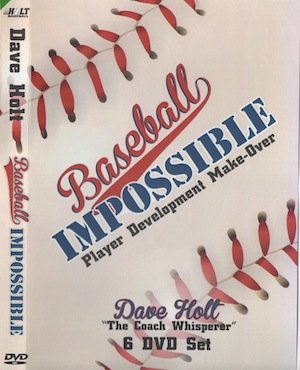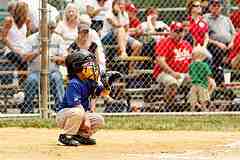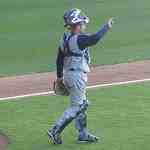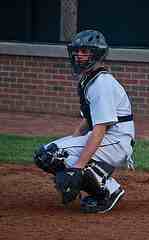Hey Friends ... sign up for my newsletter and get my
FREE Practice Checklist
Simple Baseball Signs
for Youth Catchers
Catchers give many baseball signs for youth teams. Most baseball teams will have the catchers relay the baseball coaching signs for the defensive play from the bench to the pitcher and infielders.
The bunt defense signs and plays and the 1st and 3rd situation are the most common situations for catchers giving baseball signs for youth infielders.
Catching Signs
Catchers also will be giving or receiving simple baseball signs involving pick-off plays with infielders. Picking off runners by a catcher is huge weapon for a youth baseball team.
In addition, catchers will be calling for baseball signs for pitchers to tell them what to do as far as defending the running game with various pick-offs signs, slide steps signs, inside moves, hold the ball, step backs, and pitch out signs. On top of this, the catchers must call the pitches using easy baseball signs to give to their pitcher to call the pitches.
In Addition to Easy Baseball Signs
That is not even counting all the pre-pitch reminders that catchers must do like: reminding the pitcher to “get over there” when a lefty hitter comes up. Pitchers have the responsibilty to cover 1b any time the firstbaseman vacates the position to field the ball.
Telling the pitcher to “Check with the middle infielders to see “who is covering the bag” on a comebacker with a runner on firstbase and less than two outs.
Or, reminding the pitcher “come back to me” with the bases loaded and less than two outs.
Always reminding the infielders to “throw across the diamond to firstbase” on a 3-2 count and two outs (the runners are running on the pitch so there will be no easy force play option).
And of course reminding everyone on the field know how many outs.
You can see that the catcher is involved with giving baseball signs for youth teams along with their other responsibilities. Let us look a little closer in the catchers youth baseball signs when calling pitches.
Catchers Giving Signs in Baseball
The higher you get in baseball the more apt the opposing team will be trying to steal baseball signs. If an opposing hitter knows what pitch is coming they are more likely to square up on the ball and hit the ball really hard.
Great care and concern must be put into catchers, pitchers and infielders not ‘tipping’ off the catchers’ signs. Here is a how to give baseball signs for youth catchers short coaches checklist.
1. Catchers should point their knees to the second baseman and the shortstop slightly to the left of the pitchers mound. This closes off the firstbase coach from seeing the catchers’ signs. The catchers glove should cover the area under the knee to stop the third base coach from viewing the catching signs.
2. Keep your feet together and you back relaxed and straight up. Your baseball signs are given right next to your cup area making sure the fingers cannot be seen sticking below your rear end.
3. The only players that should see the catcher giving easy baseball signs are the pitcher and the middle infielders. The corner infielders should not see the catchers signs because that would very likely allow the base coaches a visual of the pitches called and speedy base stealers peeking in to see the catchers signs to know what pitch is coming. The corner infielders will need to get a ‘quiet verbal’ sign from the middle infielders if they want to know what pitch is coming.
4. Now that all possible ‘openings’ are covered up we can now start giving baseball signs to the pitchers.
5. Typically simple baseball signs are better. Use the index finger for fastballs. You can point the finger to direct the fastball inside or outside. Some catchers when giving baseball signs for youth baseball pitches use the pinky finger for location outside to righties or inside to lefties and the index finger on the other side of the plate.
SIDE NOTE: For most youth pitchers you do not want to get too fancy since trying for the middle of the plate and low may be the best choice to get pitch over the plate.
6. Two fingers is usually the call for a curveball. There is not much choice in calling location since the ball should be curving to the outer part of the plate vs. a righty batter and hopefully end up low in the strike zone.
7. The slider is called with 3 fingers. You can use the first three fingers or the last three. The slider pitch is thrown on the outside part of the plate vs. a righty hitter and inside corner vs. lefty hitter so location is predetermined. A very high level professional pitcher may ‘back door’ the slider by starting the pitch inside vs. the righty hitter or well outside vs. the lefty hitter and see if they will give up on the pitch initially and the last moment the ball could nip the corner.
This is not recommended for the large majority of youth baseball pitchers because the command of pitches is not developed to this skill level and a pitcher will end up ‘hanging pitches’ right down the middle or missing way inside vs. a right-hand batter.
8. A subtle wiggle of all four fingers is used for a change-up pitch grip. Location is rarely needed with the changeup since we want the pitch low in the strike zone the change of speeds should make up for having to hit the corners. Down the middle and low is what you want the pitcher to focus on.
SIDE NOTE: In higher levels of baseball if the on deck is pretty close to the catcher I have heard of the on-deck batter picking up the change up sign by watching the catchers forearm.
When the tendons and the muscles in the forearm all wiggle and twitch when the fingers are moving during the change-up finger wiggle the on deck batter can let the batter know with verbal baseball signals. “Hey, wait back Billy” or something of that nature might be telling you that the on deck hitter can see the catchers signs.
Easy Baseball Signs for Youth With a Runner on Second Base
Baseball signs for youth pitchers and catchers should vary with a runner on second base. First, the pitcher and catcher do not want the runner at second base to ‘relay’ the pitches to the hitter.
Second, the runner at second base would be harder to throw out stealing thirdbase if they run on an off-speed pitch. Here is some simple ways for giving signs in baseball with a runner at second.
1. Never use the second sign. Everyone in baseball knows that most pitchers and catchers us the second sign so that is what the runner will look for first.
2. Use a first sign or a third sign in a series of 3 signs or more. Change the baseball signs up if the runner is on second base and sees 8 or more pitches. They might start catching on.
3. Use the first sign after a number, like the first sign after ‘2’ is the hot sign. These are very simple baseball signs and can be easily and quickly changed on the fly.
4. Make sure the middle infielders know when you change the signs. 5. Reverse the fastball and curveball signs. Use one finger for the curveball and two fingers for the fastball.
6. Catchers: remind your pitcher just before putting your fingers down that you will call a series of pitching signs. Just take your hand and index finger and roll it two or three times like telling the pitcher “I am rolling through the Rolex file here”.
This should prevent the pitcher from seeing the first sign and starting into the ‘stretch position’ and then stopping when they realize you were calling a series of pitching signals. Otherwise the umpire could call a ‘BALK’ on them for starting and stopping their pitching motion.
Giving Signs in Baseball Night Games
The catchers fingers may be impossible to see during some night games because the shadows make it too dark.
Some catchers will put a small strip of white tape around their fingers or paint whiteout on their fingernails. You should have an ‘outside set’ of baseball signs ready to use too.
You can touch parts of your body like a third base coach gives baseball batting signs and baseball signs to youth players.
Another way is to position your glove in different ways. The fingers are the ‘decoy baseball signs’. The glove is left in the traditional fashion for the fastball, turned around for the curve ball, left flat on the thigh for the changeup, and placed up right on the thigh for the slider.
Giving Baseball Signs for Youth
This is one of the reasons I wanted to be a catcher. Catching is very, very busy and lots of work which was right up my ally.
It seemed a little boring to go play another position after playing catcher.
Giving baseball signs for youth, using simple baseball signs, looking for baseball coaching signs from the bench, putting on the baseball coach signals to the defense and giving signs in baseball situations for pick off plays was a blast for me and should be for your catchers too.
Back to Home from Baseball Signs for Youth
More Baseball Signs for Youth
Super Simple Guide to Coach and Play Baseball
Baseball Impossible: Player Development Make-Over
Build Your Own Culture of Player Development
&
Increase Your Players FUN Level
6-DVD Video Set Building Your Complete Player Development System
Click to Order
Audio CD Format Click Here

Coaching 6-DVD Box Set
Yes Dave, I Want to Help My Players Enjoy the GAME
Coaching little league baseball & youth baseball can be a blast or could be a Tough Gig.
Who in their right mind would come back year after year and have teasing baseball practice and never improve their baseball skills? and get welled at by adults?
Baseball Coaching Videos: Watch over 6 hours of tips on coaching approach, style, philosophy, and my unique player development system.
Youth baseball carers are short-lived so lets make it count for our players. What do players really want out of playing baseball?
I want to find out more about the 6 DVD Player Development System
How to
Jump-Start Your Coaching Skills
"5 Steps to Ultimate Baseball Coaching Excellence"
Who: All baseball & softball coaching age levels
What: Teaches approach, philosophy, practice planning, drills, game management, communication skills, player development methods, and more. No other course compares.
5 Steps to Ultimate Baseball Coaching Excellence
Order Now
High Tempo© Baseball Development Systems
New innovative, accelerated youth baseball practice and competitive game format made to increase player development and the kids have a blast.
High Tempo© Baseball Development Systems
Phase I: High Tempo© Team Practice System
Phase II High Tempo© Competitive Game Modification System
Order Now
3 Course Bundle...Best Value
Downloadable eBooks
Check out these vitally important eBooks to include in your coaching library.
"Time to Shine: My Baseball Coaches Practice System 7 Year Plan to Help Kids Reach HS Baseball
"Build Your Ultimate Culture of Hitting"
Take a look at all the coaching products that will make your coaching experience top of the line and help bring your player's enjoyment level much higher.




